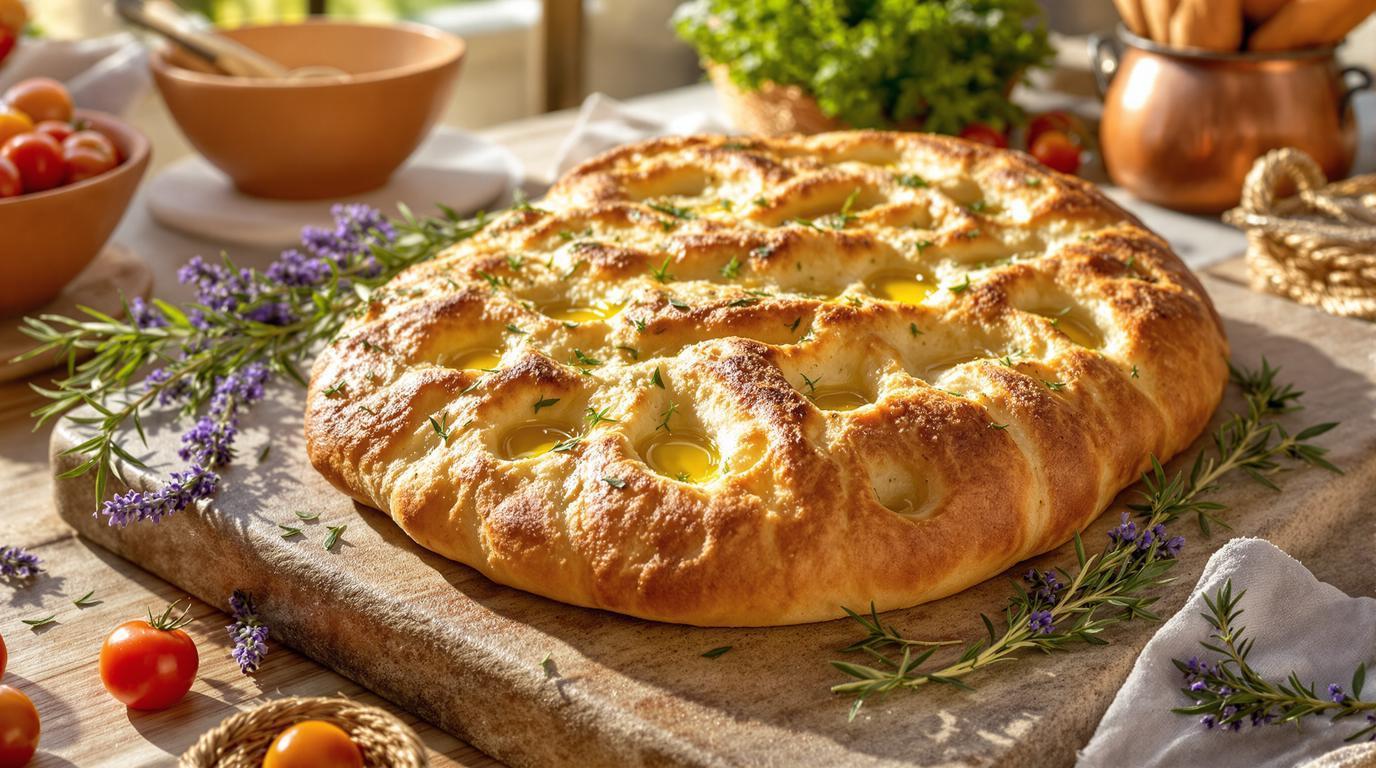I still remember the first time I tasted authentic focaccia aux herbes de Provence during my apprenticeship in the South of France. The head chef—a stern woman who rarely smiled—placed a warm rectangle of bread before me, its golden surface dimpled with pockets of glistening olive oil and speckled with purple lavender and green herbs. “This is how my grandmother taught me,” she said. One bite revealed a perfect paradox: a crisp exterior yielding to a tender, aromatic interior that somehow captured the essence of Mediterranean sunshine. Today, I’m sharing my adaptation of this beautiful bread that marries Italian technique with French flavor.
The Story
Focaccia is traditionally Italian, but this version incorporates the quintessential herb blend of Provence—a fragrant mix typically including thyme, rosemary, oregano, savory, and sometimes lavender. Unlike its more elaborately shaped French cousin fougasse, focaccia remains a simple flatbread, distinguished by its characteristic dimples that create tiny pools of flavor. It’s the kind of bread that accompanies almost any meal beautifully, but stands confidently on its own with nothing more than good olive oil for dipping. When I serve this at dinner parties, guests inevitably ask for the recipe—always a good sign!
This recipe deliberately avoids pre-ferments like poolish, embracing the straightforward approach that would have been used in traditional home kitchens, where bread was made daily without fuss or complexity.
Ingredients Spotlight
For one large focaccia (serves 6-8):
- 500g (4¼ cups) bread flour
- 350ml (1½ cups) warm water (about 38°C/100°F)
- 10g (2 tsp) active dry yeast
- 15g (3 tbsp) herbes de Provence
- 10g (2 tsp) fine sea salt
- 40ml (3 tbsp) extra virgin olive oil, plus extra for drizzling
- Fleur de sel or coarse sea salt for topping
- Optional: 2 cloves thinly sliced garlic, cherry tomatoes halved
The bread flour is crucial here—its higher protein content creates the chewy interior structure we’re after. And don’t skimp on olive oil quality; its flavor permeates the entire bread. I use a locally pressed oil with grassy notes that complement the herbal profile beautifully.
Step-by-Step Guide
1. Activate the yeast: In a small bowl, combine warm water and yeast. Stir gently and let sit for 5-10 minutes until foamy and fragrant.
2. Make the dough: In a large bowl, whisk together flour, salt, and 2 tablespoons of the herbes de Provence. Create a well in the center and pour in the yeast mixture and 3 tablespoons olive oil. Mix with a wooden spoon until a shaggy dough forms.
3. Knead: Turn onto a lightly floured surface and knead for 8-10 minutes until smooth and elastic. The dough should be slightly tacky but not sticky—add minimal flour as needed.
4. First rise: Place dough in a lightly oiled bowl, turning to coat. Cover with a damp cloth and let rise in a warm spot for 60-90 minutes until doubled in size.
5. Shape: Oil a large baking sheet (approximately 30 × 40cm). Gently press the dough into a rectangle about 2cm thick. Use your fingertips to create deep dimples all over the surface without tearing through.
6. Second rise: Cover loosely with plastic wrap and let rise another 30-45 minutes until puffy.
7. Prepare for baking: Preheat oven to 220°C (425°F). Drizzle the focaccia generously with olive oil, allowing it to pool in the dimples. Sprinkle with the remaining herbs, fleur de sel, and any optional toppings.
8. Bake: Bake for 20-25 minutes until golden brown and crisp on top. The internal temperature should reach 96°C (205°F).
9. Finish: Brush with more olive oil while still hot. Cool for at least 15 minutes before slicing.
Expert Techniques
The signature dimpling technique serves multiple purposes—it creates texture, prevents the dough from rising too much during baking, and forms little reservoirs for olive oil. When dimpling, keep your fingers well-oiled to prevent sticking, and press firmly but not aggressively.
Chef’s Note: The most common mistake I see is under-oiling the focaccia. Be generous—what seems like too much olive oil before baking will be absorbed, creating that characteristic richness. My grandmother would say “until the dough looks like it’s taking a bath in oil, add more!”
For an extra-crispy bottom crust, preheat a baking stone or inverted heavy baking sheet in the oven, then slide your prepared focaccia (on its baking sheet) directly onto this hot surface.
Presentation & Pairing Ideas
For maximum impact, serve this focaccia warm, torn rather than cut to showcase its rustic nature. The traditional pairing in Provence would be a chilled rosé wine, but it also works beautifully with a crisp white like Vermentino or a light red like Grenache.
Create a simple Mediterranean appetizer board by surrounding torn focaccia with olive tapenade, roasted red peppers, fresh goat cheese, and perhaps some praline-topped nuts for sweet contrast. For a heartier meal, serve alongside a Provençal vegetable soup or crispy-edged frittata.
For seasonal variations, try incorporating the first tender herbs of spring, summer cherry tomatoes pressed into the dough before baking, or autumn wild mushrooms sautéed and scattered over the bread just before serving.
Remember that this focaccia is best the day it’s made, but can be refreshed in a hot oven for a few minutes if needed. If you’re looking for a sweeter baking project afterward, consider my buttermilk chocolate cupcakes or Vietnamese honeycomb cake for contrast.
The true beauty of this recipe is that while I’ve given you a framework, the final expression is yours to create. Add more herbs, try different toppings, experiment with the shape—make it your own, and like all great recipes passed through generations, it will evolve to tell your unique culinary story. 🌿✨
